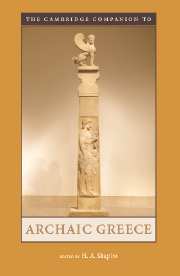5 - Homer, Hesiod, and the Epic Tradition
from Part 2 - Literature and Philosophy
Published online by Cambridge University Press: 28 November 2009
Summary
A series of Greek vase paintings dating from 670 to 625 BCE depict up to five men blinding another figure with an elongated, pole-like object (see Figure 15). These vases have been thought to represent Odysseus' wounding of the drunken Cyclops, Polyphemus, as recounted by Odysseus himself in the Odyssey (9.105-566). Such an interpretation depends upon understanding the Odyssey to have been composed sometime before the first of these vase paintings and to have influenced artists soon after its appearance. Indeed, it is hard to overstate the importance of not only the Homeric but also the Hesiodic poems to the ancient world. Herodotus claimed the two taught the Greeks about their gods (2.53), and Homeric poetry became fundamental to Greek and Roman education. It was only natural that in order to examine the history of Rome and the domestic policies of the emperor Augustus, Virgil rewrote the stories of Achilles, Hector, and Odysseus. The popularity of the poems has hardly waned since then. In Omeros (1990), Derek Walcott explores the postcolonial Caribbean through the lens of Homeric epic. The narrators of Margaret Atwood's Penelopiad (2005) are Penelope and the maids whom Odysseus has killed after he dispatches the suitors (Odyssey 22.437-73). Yet despite all the attention lavished on the poems since antiquity they are far from known quantities. Let us return to Odysseus and the Cyclops.
- Type
- Chapter
- Information
- The Cambridge Companion to Archaic Greece , pp. 111 - 140Publisher: Cambridge University PressPrint publication year: 2007
- 2
- Cited by

